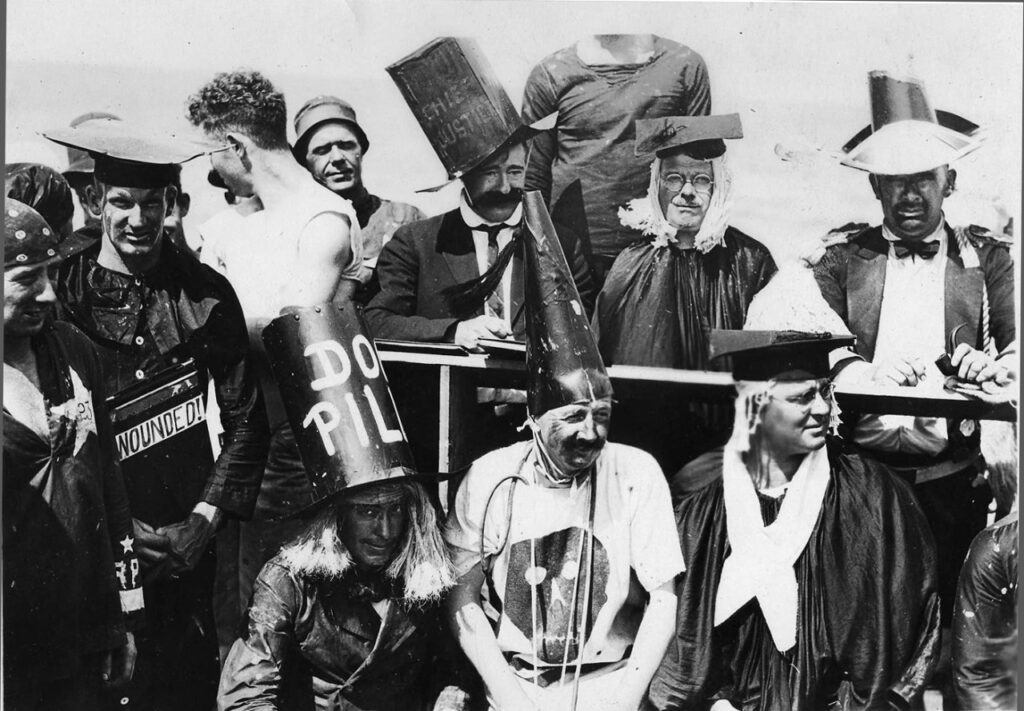USS Franklin Initiated Into The “Solemn Mysteries of the Ancient Order of the Deep”

Big Ben and her crew arrived in the Pacific Theater in July 1944. By 20 September, she had seen a great deal of action in the short time she had been there. She earned her first battle star when her aircraft attacked Japanese bases at Iwo and Chichi Jima. Next, she supported the landings at Guam. In late July, she attacked the enemy at Yap, Palau, and Ulithi.
She earned her second battle star in the Western Carolines operation. Again, she struck Iwo and Chichi Jima, then Yap and Ulithi. In mid-September, she supported the invasion of Peleliu and attacked the Anguar Islands and Palau.1
On 20 September 1944, she crossed the Equator triggering a tradition hundreds of years old called The Crossing of the Line.
During the latter part of September, we were ordered to the Admiralty Islands to reprovision. This of course necessitated our crossing the Equator, which was an interesting day in-as-much as there were about forty Polliwogs per Shellback aboard.2
The “Solemn Mysteries of the Ancient Order of the Deep”
A ceremony is held in many navies when a ship crosses the Equator. It goes back hundreds of years. During World War II, it could be painful to the Polliwogs, as the first-timers were called. In his book, So Long For Now A Sailor’s Letters From The Franklin, historian Jerry L. Rogers writes that those who had crossed the line before were “Shellbacks.” One shellback is designated as “King Neptune,” in charge of the ceremony, and another as the “Royal Baby.” Polliwogs had to kiss his navel. On Big Ben that day,
polliwogs were shaved and hung upside down while their scalps were dipped in a bowl of mercurochrome to eyebrow level, dying their scalps bright red.3
Shellbacks are considered to have been initiated into the Solemn Mysteries of the Ancient Order of the Deep.
“Good Humored Mischief” or Painful Hazing”
The official History of Bombing Squadron 13 and the Naval History and Heritage website would have you believe that it was just good clean mischief. The unknown author of The History of Bombing Squadron 13 writes
About four days later we had the ship all gathered up and assembled again and arrived at Manus Island sans hair but with a good time under our belts.4
But if you watch the documentary, USS Franklin: Honor Restored, you’ll see and hear George Sippel, a crewmember say
If I live to be a thousand, I’ll never forget crossing the equator. Punishment was pretty bad. Sickbay was filled with people who got hurt kinda bad.5
Generally, most polliwogs enjoyed their initiation, helped by the knowledge that next time they’d be on the other side as shellbacks. Others recovered from their wounds. New shellbacks received certificates that they had been properly initiated into “The Solemn Mysteries.”
After they reached the Admiralty Islands and finished reprovisioning, it was back to the war. October 1944 beckoned.
Did you arrive here via a search engine? I am the author of the forthcoming book, Heroes By The Hundreds: The Story of the USS Franklin (CV-13). In addition to writing about the bravery of the crews that saved her, I will be writing about the lessons we can learn in leadership and crisis management. I’ll also write about the changes the US Navy made as a result of those lessons learned.
I send out a monthly newsletter, Glenn’s After-Action Report, writing about subjects I find interesting in my research. You can sign up for it below. Feel free to leave a comment or ask a question. Thanks for reading.-Glenn
Footnotes
- USS Franklin (CV-13) Original Documents 1943-1946, Brief History of USS Franklin CV-13 (Paducah, KY: Turner Publishing Co. 1994) 76-77
- Original Documents, Brief History of Bombing Squadron 13, 47
- JerryL. Rogers, So Long For Now (Norman: University of Oklahoma Press, 2017) 193-194
- The History of Bombing Squadron 13, 47
- USS Franklin: Honor Restored (https://search.alexanderstreet.com/view/work/bibliographic_entity%7Cvideo_work%7C2179201)